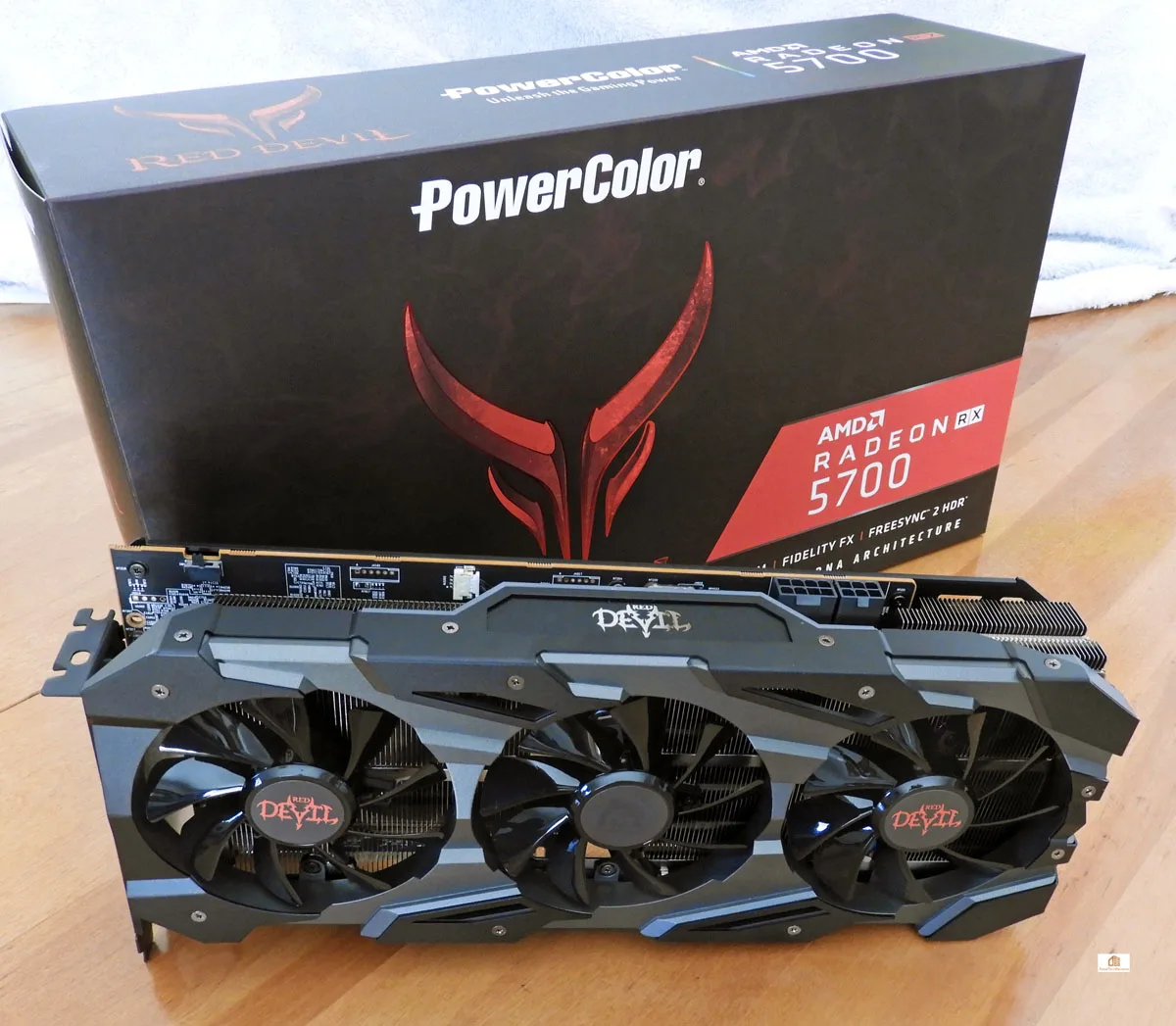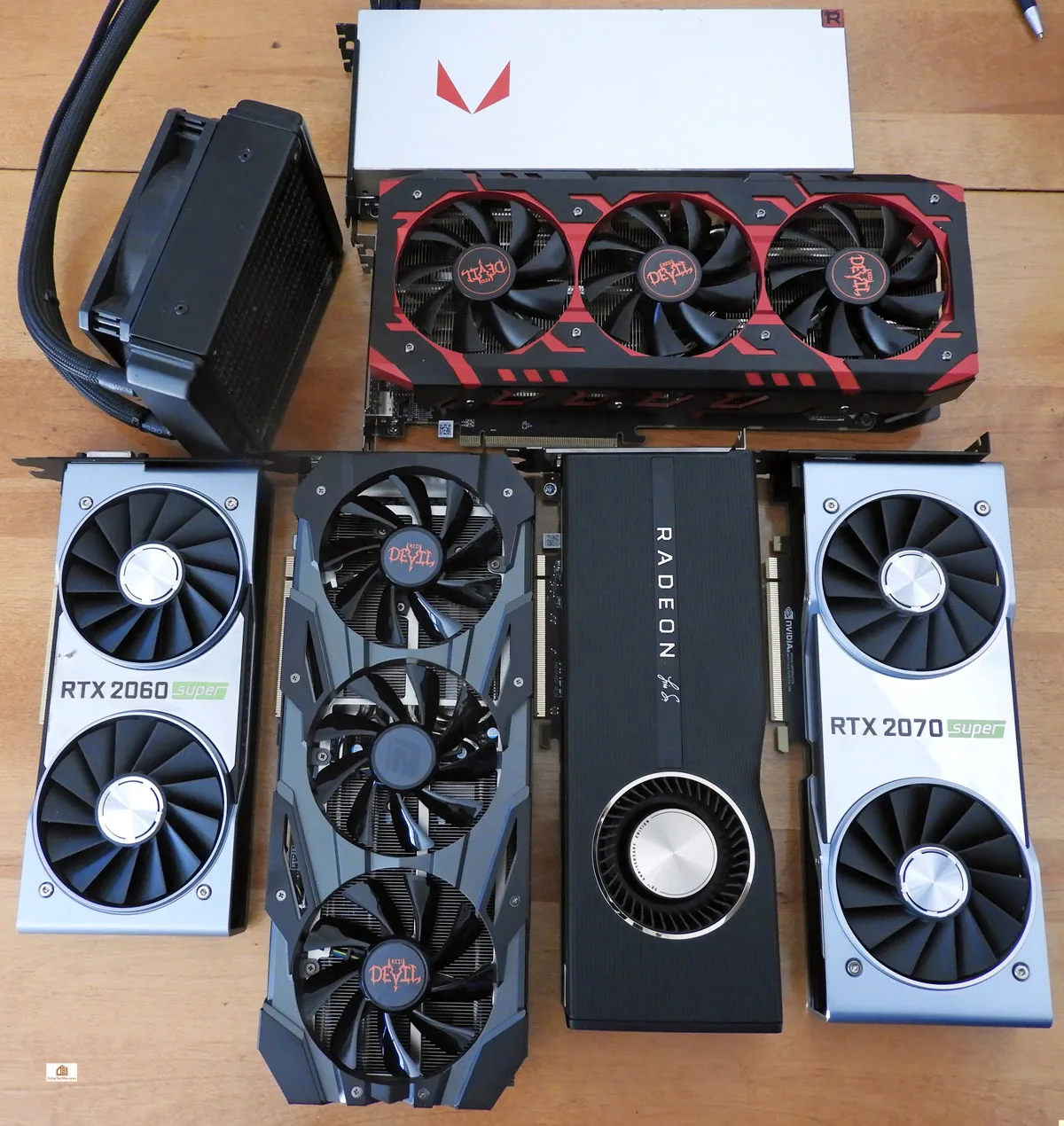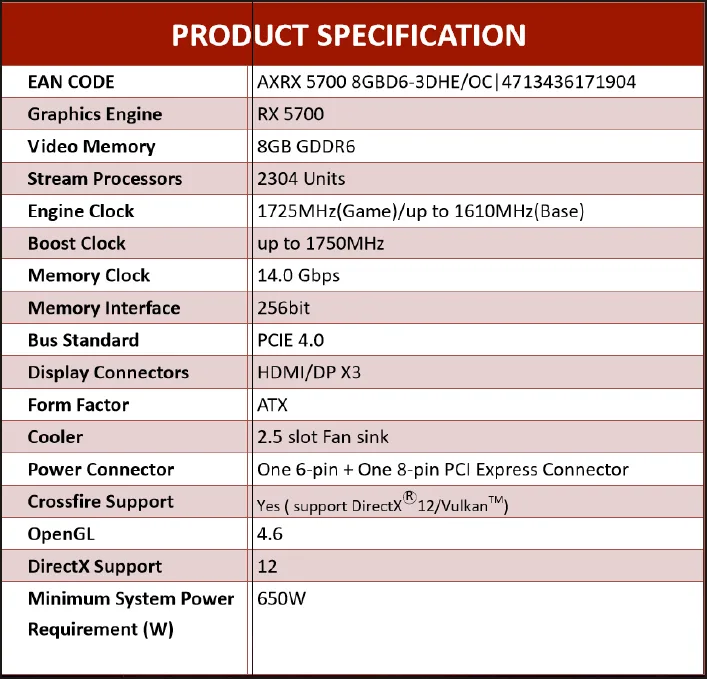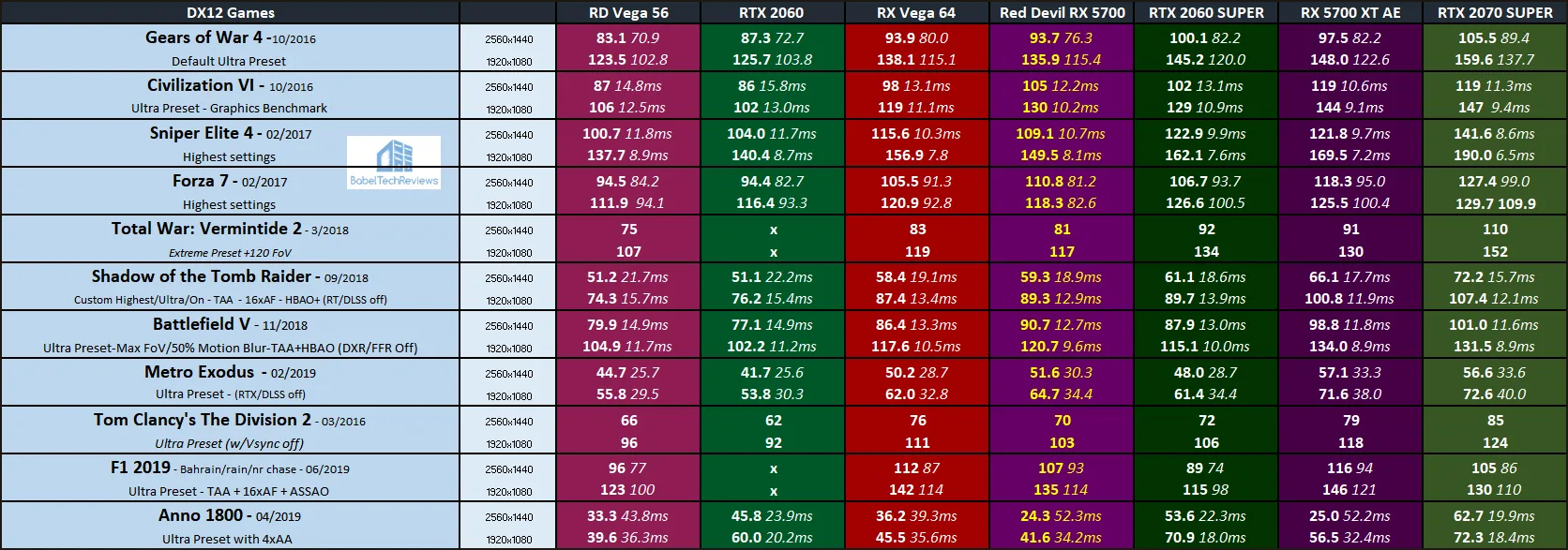The PowerColor Red Devil RX 5700 takes on the RTX 2060 & RTX 2060 SUPER in 44 Games
The Red Devil RX 5700 arrived yesterday at BTR for evaluation priced at $389. We have been benching it versus the $349 RTX 2060 Founders Edition (FE) and the $399 RTX 2060 SUPER FE video cards using 44 games and 3 synthetic benchmarks.
We will also compare the performance of these three competing cards with the RX 5700 XT Anniversary Edition (AE), the RTX 2070 SUPER FE, the liquid-cooled Vega 64 and the Red Devil RX Vega 56. Ten other cards’ recent performance results are also included to complete BTR’s Big Picture.
The Red Devil RX 5700 is factory clocked +25MHz higher than the reference version. According to its specifications, the Red Devil RX 5700 boost can clock up to 1750MHz while the reference card clocks up to 1725MHz. It also looks different from the classic Red Devils, arriving in a more neutral gray color instead of in all red and black. For the first time, the Red Devil RX 5700 features a RGB mode which is supported in AMD’s drivers. Its LEDs default to a bright red which may be customized by the included DevilZone software.
The Red Devil RX 5700 Features & Specifications
Here are the Red Devil RX 5700 features according to PowerColor:
Features
- The card has 2 modes, Overclock and Silent which have a 180W and 160W power target respectively. These modes are activated by a a BIOS switch on the side of the card. It is designed to be very quiet. The overclock mode is considerably quieter than the reference RX 5700’s blower, but the silent mode is whisper quiet.
- The board has 10 Phase VS; the 7 Phase VRM design on the reference design is over spec’d in order to deliver excellent stability and overclocking headroom. The difference is the 300W of the Red Devil versus the 220W of the reference design.
- DrMos and high-polymer Caps
- The cooler features 2 x 100mm ball bearing fans with 5 heat pipes across a high density heatsink with a copper base. The PCB is shorter than the cooler – 240mm for the PCB and 300mm for the cooler. Besides having more dissipation area, because the PCB is shorter than the cooler, its efficiency is improved since the hot air isn’t trapped as easily.
- The Red Devil RX 5700 now has RGB lighting! Full RGB support is targeted by the next Adrenalin Software driver release.
- The Red Devil RX 5700 cooler shroud is now more neutral and it’s easier for buyers to customize their gaming color scheme with RGB lighting. And the ports are LED illuminated.
- All Red Devil RX 5700 are bundled with the AMD promotional Xbox Game pass for 3 months.
- A Devil Club invitation is included to give access to PowerColor news, competitions, downloads, and instant support via live chat.
Specifications
Here are PowerColor’s Red Devil RX 5700 specifications.
The Test Bed
BTR’s test bed consists of 44 games and 3 synthetic benchmarks at 1920×1080 and at 2560×1440. Our newest game is Wolfenstein: Youngblood which we just validated for benching yesterday. The testing platform is a recent install of Windows 10 64-bit Home Edition, and we are using an i7-8700K which turbos all 6 cores to 4.8GHz, an EVGA Z370 FTW motherboard, and 16GB of T-FORCE XTREEM DDR4 3866MHz. The games, settings, and hardware are identical except for the cards being compared.
First, let’s take a closer look at the new PowerColor Red Devil RX 5700.
A Closer Look at the PowerColor Red Devil RX 5700
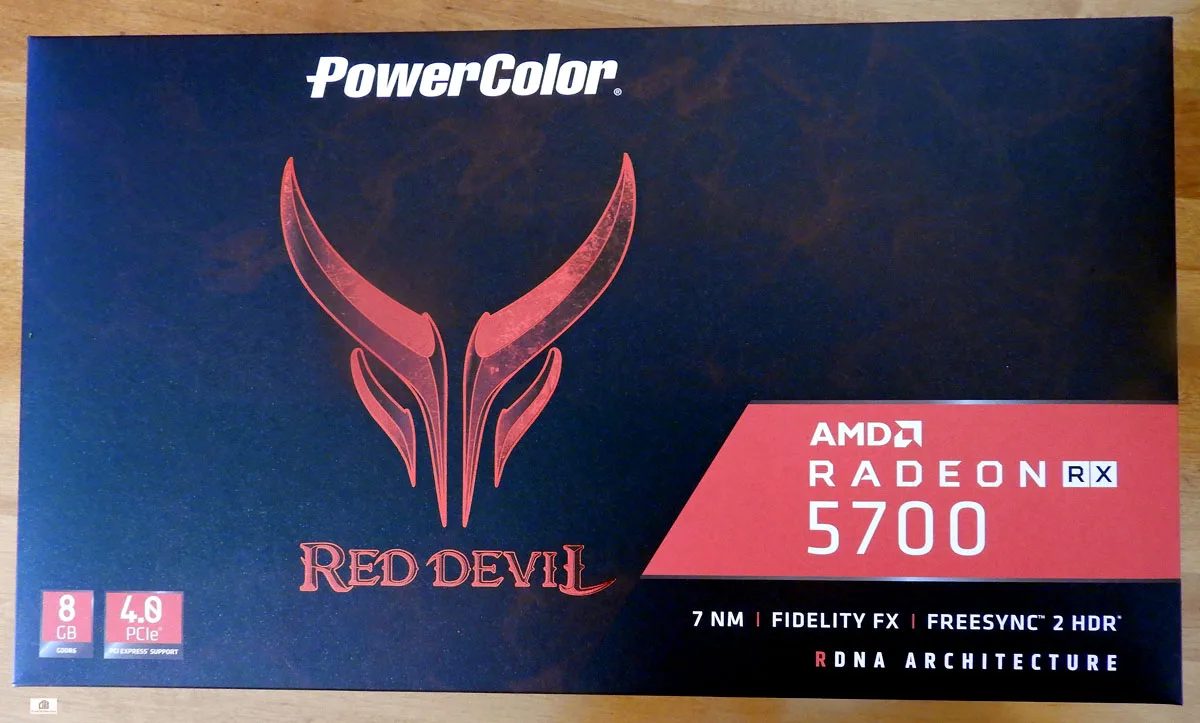 The Red Devil RX 5700 advertises itself as a premium 7nm card on AMD’s RDNA architecture which features FidelityFX, FreeSync 2 HDR and PCIe 4.0.
The Red Devil RX 5700 advertises itself as a premium 7nm card on AMD’s RDNA architecture which features FidelityFX, FreeSync 2 HDR and PCIe 4.0.
The back of the box touts its key features as well as it’s 650W power and system requirements. AMD’s technology features are highlighted, and the box also emphasizes PowerColor’s cooling solution, Dual-BIOSes, RGB software, and output LEDs. 
Opening its very well-padded box, we see a quick installation guide, driver CD, and an invitation to join PowerColor’s Devil’s Club. In addition, a code for a 3-month XBox Game Pass is included.
 The Red Devil RX 5700 is a large tri-fan card in a 2.5 slot design which is quite handsome with PowerColor’s new colors and even more striking with the RGB on.
The Red Devil RX 5700 is a large tri-fan card in a 2.5 slot design which is quite handsome with PowerColor’s new colors and even more striking with the RGB on. 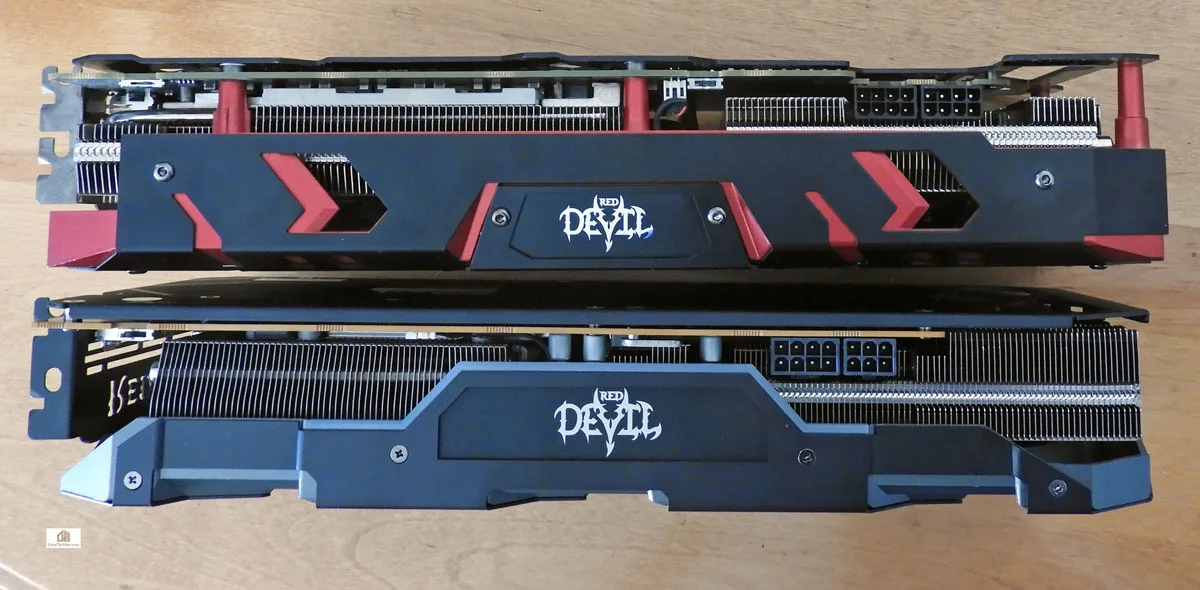 Although it is the same size as the Red Devil RX Vega 56, it is about 1/2 inch thinner. It uses two PCIe connections, a 1×8-pin and a 1×6-pin.
Although it is the same size as the Red Devil RX Vega 56, it is about 1/2 inch thinner. It uses two PCIe connections, a 1×8-pin and a 1×6-pin.  From the other side we can see the cooler fins overhanging the PCB.
From the other side we can see the cooler fins overhanging the PCB.
 The PowerColor Red Devil RX 5700’s sturdy backplate no longer features a pentagram. Instead there is a stylized custom devil symbol that lights up in the color of your choice.
The PowerColor Red Devil RX 5700’s sturdy backplate no longer features a pentagram. Instead there is a stylized custom devil symbol that lights up in the color of your choice.
 The Red Devil’s RX 5700’s connectors include 3 DisplayPorts, 1 HDMI connection, and a Dual-Link DVI connector. They are conveniently LED lit for plugging in cables without needing to turn on the lights.
The Red Devil’s RX 5700’s connectors include 3 DisplayPorts, 1 HDMI connection, and a Dual-Link DVI connector. They are conveniently LED lit for plugging in cables without needing to turn on the lights.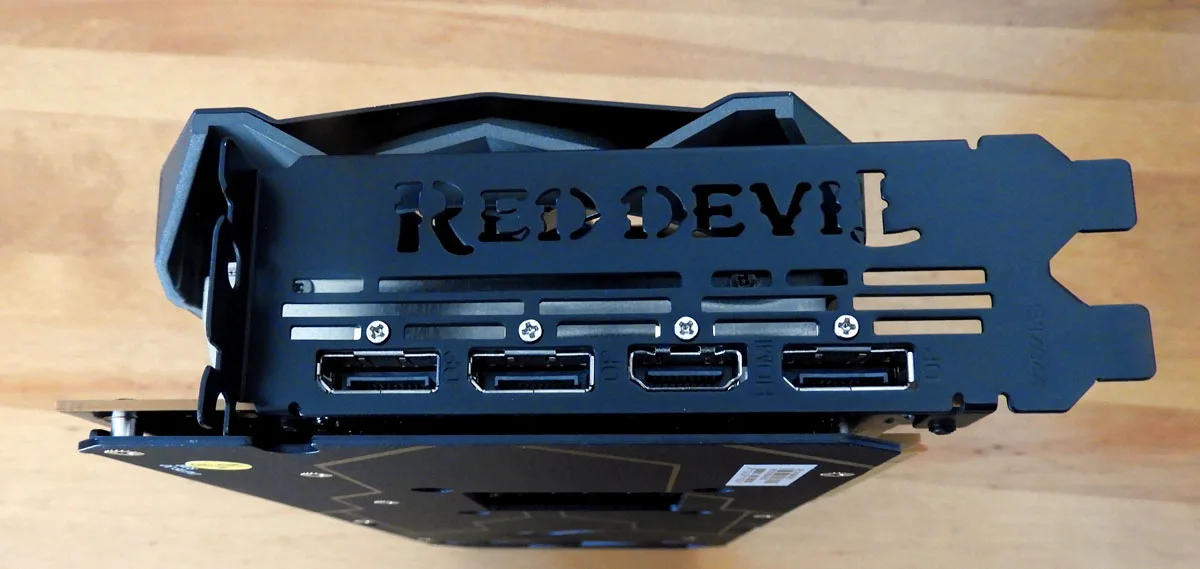
The specifications look good and the card itself looks great with its default RGB bright red contrasting with the black backplate.
Finally here is an image of the PCB courtesy of PowerColor.
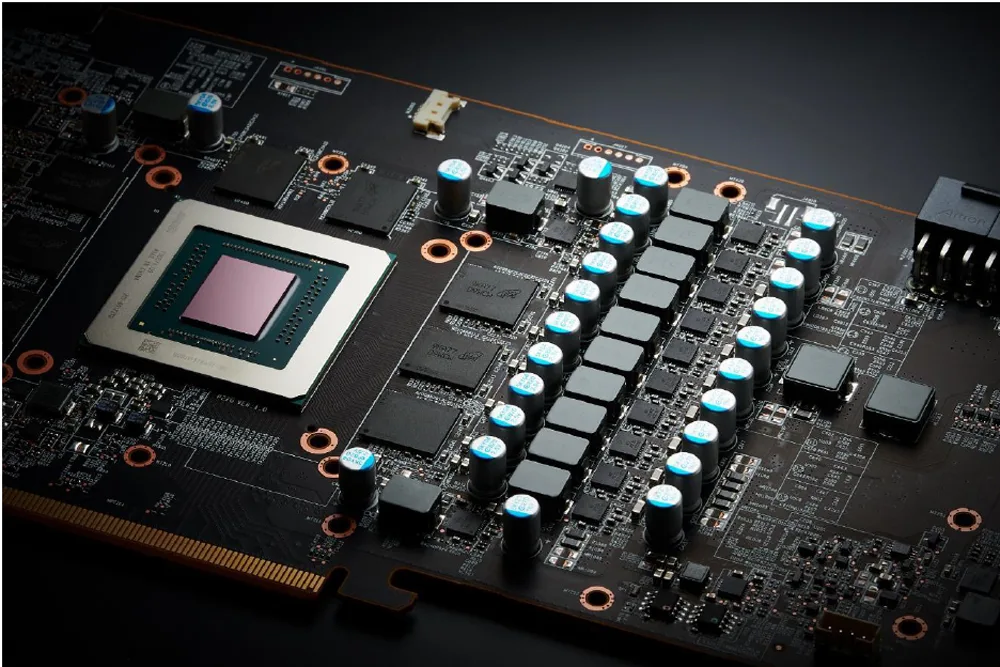
Let’s check out its performance after we look over our test configuration and more on the next page.
Test Configuration – Hardware
- Intel Core i7-8700K (HyperThreading and Turbo boost are on to 4.8GHz for all cores; Coffee Lake DX11 CPU graphics).
- EVGA Z370 FTW motherboard (Intel Z370 chipset, latest BIOS, PCIe 3.0/3.1 specification, CrossFire/SLI 8x+8x), supplied by EVGA
- T-FORCE XTREEM (2×8 GB, dual channel at 3866 MHz), supplied by Team Group
- Red Devil RX 5700 8GB, at Red Devil clocks, on loan from PowerColor
- RX 5700 XT Anniversary Edition 8 GB, at stock AE speeds
- Red Devil RX Vega 56 8GB, at Red Devil clocks, on loan from PowerColor
- Gigabyte RX Vega 64 8GB, Liquid-cooled edition, at liquid cooled edition clocks
- GeForce RTX 2060 6GB Founders Edition, at Founder Edition clocks, on loan from NVIDIA
- GeForce RTX 2060 SUPER 8GB Founders Edition, at Founder Edition clocks, on loan from NVIDIA
- GeForce RTX 2070 SUPER 8GB Founders Edition, at Founder Edition clocks, on loan from NVIDIA
- 9 other cards are included in the Big Picture as listed on its chart. The RX 5700 XT is the Anniversary edition at stock RX 5700 XT clocks (the only difference is that the Anniversary edition GPU is binned, overclocked 75MHz, and with a 10W higher board power).
- EVGA Nu Audio PCIe soundcard, supplied by EVGA
- 480 GB Team Group SSD
- 1.92 TB San Disk enterprise class SSD
- 2 TB Micron 1100 SSD
- 500GB T-FORCE Vulcan SSD, supplied by Team Group
- Seasonic 850W Gold Focus power supply unit
- EVGA CLC 280mm CPU water cooler, supplied by EVGA
- Onboard Realtek Audio
- Edifier R1280T active speakers
- EVGA DG-77, mid-tower case supplied by EVGA
- Monoprice Crystal Pro 4K
Test Configuration – Software
- AMD’s Radeon Software Adrenalin Edition 19.8.1 for the RX 5700/XT and the RX Vega 56/64. The Big Picture chart lists the driver used for each of the other Radeons.
- NVIDIA’s GeForce 431.16 drivers used for the RTX 2060 and 2060/2070 SUPER cards. The Big Picture chart lists the driver used for each of the other GeForce cards.
- VSync is forced off.
- AA enabled as noted in games; all in-game settings are specified
- Gaming results show average frame rates in bold including minimum frame rates shown on the chart next to the averages in a smaller italics font.
- Highest quality sound (stereo) used in all games.
- Windows 10 64-bit Home edition v1903. All DX11 titles were run under DX11 render paths. DX12 titles are generally run under the DX12 render path unless performance is lower than with DX11; Hitman 2 and TW: Warhammer II are run on both pathways. Three games use the Vulkan API.
- Latest DirectX
- All games are patched to their latest versions at time of publication
- Wattman
- OCAT
- Fraps
44 PC Game benchmark suite & 3 synthetic tests
Synthetic
- Firestrike – Basic & Extreme
- Time Spy DX12
- Superposition
DX11 Games
- Grand Theft Auto V
- The Witcher 3
- Fallout 4
- Rainbow Six Siege
- Overwatch
- For Honor
- Ghost Recon Wildlands
- Mass Effect: Andromeda
- Prey
- ARK: Survival Evolved
- Project CARS 2
- Middle Earth: Shadow of War
- Total War: Warhammer II
- Destiny 2
- Star Wars: Battlefront II
- Monster Hunter: World
- Kingdom Come: Deliverance
- Final Fantasy XV
- Far Cry 5
- Conan: Exiles
- F1 2018
- Assassin’s Creed: Odyssey
- Call of Duty: Black Ops 4
- Hitman 2
- Just Cause 4
- Resident Evil 2
- Anthem
- Devil May Cry 5
- Far Cry New Dawn
DX12 Games
- Gears of War 4
- Civilization VI
- Sniper Elite 4
- Forza 7
- Total War: Warhammer II
- Total War: Vermintide II
- Shadow of the Tomb Raider
- Battlefield V
- Hitman 2
- Metro Exodus
- Tom Clancy’s The Division 2
- F1 2019
- Anno 1800
Vulkan Games
- DOOM
- Wolfenstein: The New Colossus
- Strange Brigade
- Wolfenstein: Youngblood
AMD Control Center Radeon Settings
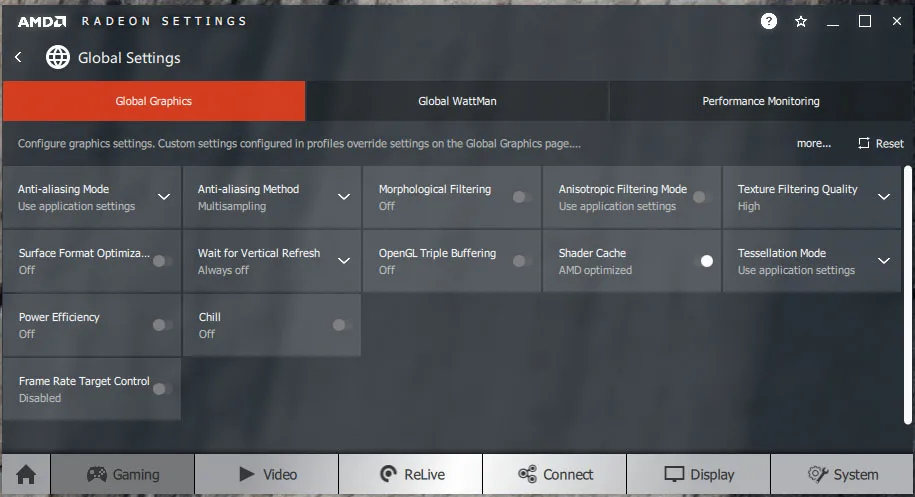 All AMD settings are set so as to be apples-to-apples when compared to NVIDIA’s control panel settings – all optimizations are off, Vsync is forced off, Texture filtering is set to High, and Tessellation uses application settings.
All AMD settings are set so as to be apples-to-apples when compared to NVIDIA’s control panel settings – all optimizations are off, Vsync is forced off, Texture filtering is set to High, and Tessellation uses application settings.
We used Wattman to set power, temperature and fan limits are set to their maximums to prevent throttling for all Radeons.
NVIDIA Control Panel settings
Here are the NVIDIA Control Panel settings.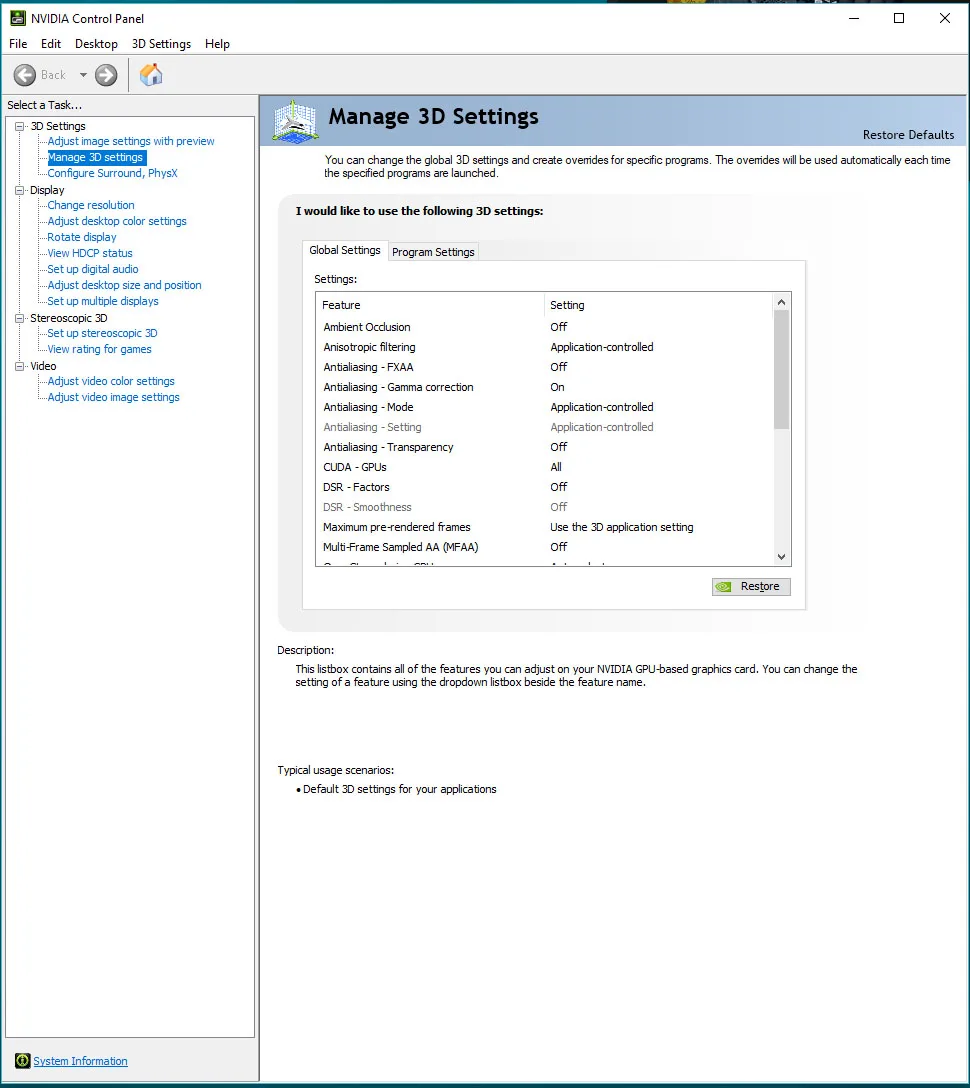
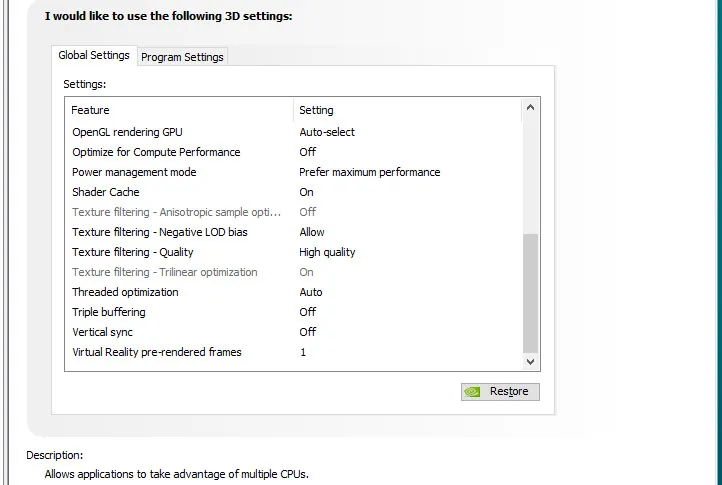 We used MSI’s Afterburner to set our GeForce cards’ highest Power and Temperature targets. By setting the Power Limits and Temperature limits to maximum for each card, they do not throttle, but they can each reach and maintain their individual maximum clocks, stock or overclocked.
We used MSI’s Afterburner to set our GeForce cards’ highest Power and Temperature targets. By setting the Power Limits and Temperature limits to maximum for each card, they do not throttle, but they can each reach and maintain their individual maximum clocks, stock or overclocked.
Let’s check out Red Devil RX 5700 overclocking, temperatures and noise next.
Overclocking, temperatures and noise … and RGB
We couldn’t spend any time overclocking the Red Devil RX 5700 for this review as we barely had 24 hours to evaluate it. We used the Performance BIOS for this evaluation, and we will follow up in our next review by overclocking as far as we can go in an overclocking showdown with the RTX 2060 starting tomorrow.
Here are the PowerColor Red Devil RX 5700 default settings with the power limit set to its maximum +20%. For this card, the performance didn’t matter whether it was set to default or +20% unlike with the RX 5700 XT Anniversary edition which gained performance as the Power Limit increased right up to its maximum.
The Red Devil RX 5700’s clocks are specified to boost “up to 1750MHz” but our sample can peak up to 1785MHz under full load, and it averages around 1780MHz. The Red Devil’s temperatures stay low in the mid-70s C with the fans quietly running under 1200 rpm.
Even using the Performance BIOS, the card’s fans are difficult to hear over the fans in our PC, but it will become even more inaudible while gaming by using the Silent BIOS which is especially welcome for those who prefer a very quiet system.
For those who want to see the performance settings and overclocking results, check back this weekend for our Red Devil RX 5700 overclocking showdown versus the RTX 2060.
The DevilZone RGB
RGB works with the Red Devil RX 5700 and will be enabled with the very next Adrenalin Software Update. We have the drivers now and the DevilZone program.
There are many ways to customize your lighting as you can see from the choices above. If you do not install the software, you will get the default red that looks great with black.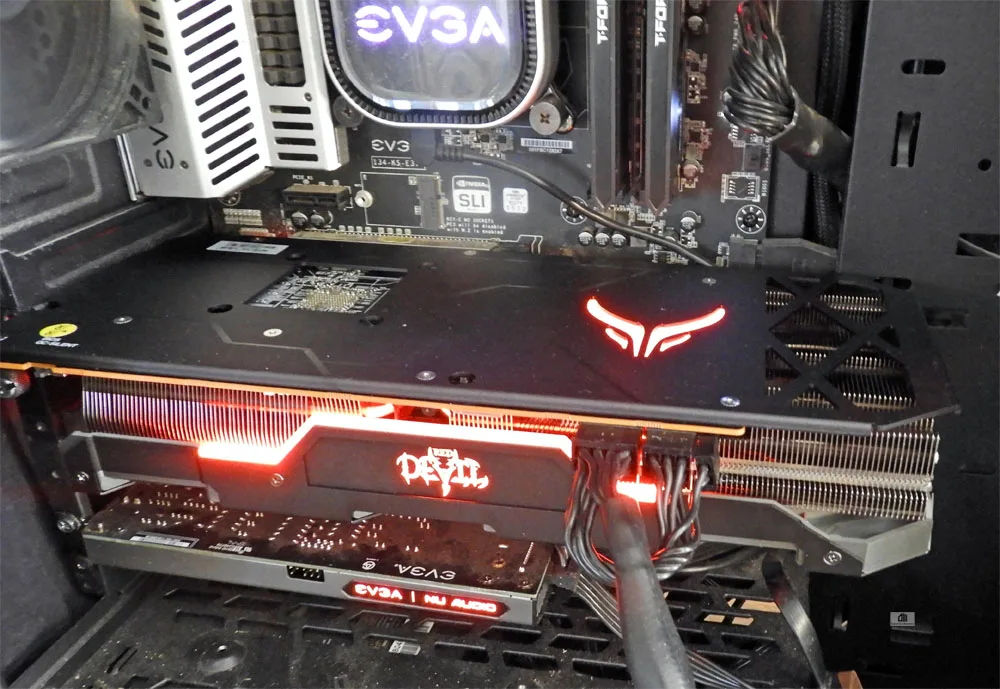
But let’s say you want green. 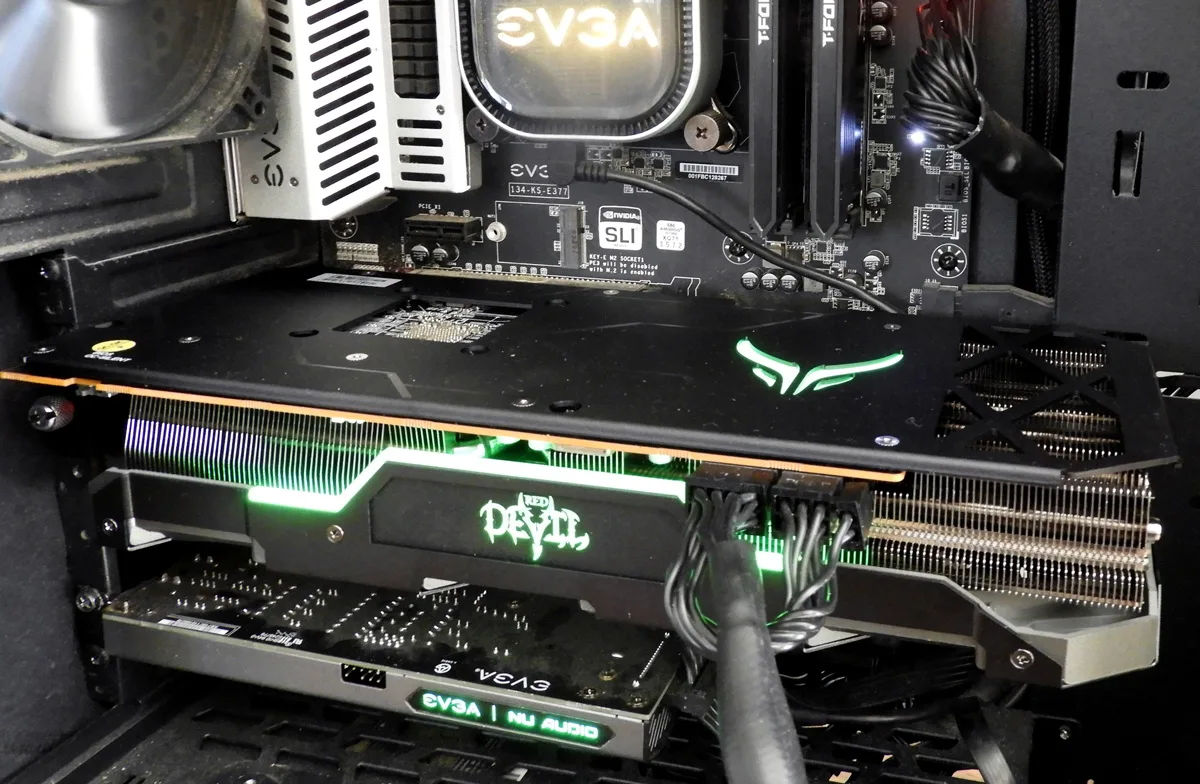 It’s no problem, unlike with NVIDIA’s Founders Editions which do not allow for any color changes to their LEDs.
It’s no problem, unlike with NVIDIA’s Founders Editions which do not allow for any color changes to their LEDs.
Let’s head to the performance charts to see how the performance of the PowerColor RX 5700 at reference Red Devil clocks compares with the RTX 2060 FE, the RTX 2060 SUPER FE, and with 13 other cards.
Performance summary charts
We give the performance results of 44 games and 3 synthetic tests comparing the Red Devil RX 5700 8GB with the RTX 2060 FE 6GB, the RTX 2060 SUPER FE 8GB, and versus the RX 5700 XT and RTX 2070 SUPER FE. In addition, we have added the PowerColor Red Devil RX Vega 56 and the liquid-cooled RX Vega 64 for comparison.
The highest settings are used and listed on the charts. The benches were run at 1920×1080 and at 2560×1440. Open each chart in a separate window or a tab for best viewing.
Most gaming results show average framerates in bold text, and higher is better. Minimum framerates are next to the averages in italics and in a slightly smaller font. The games benched with OCAT show average framerates but the minimums are expressed by frametimes in ms where lower numbers are better.
The Red Devil RX 5700 vs. the RTX 2060 FE and vs. the RTX 2060 SUPER FE
The first set of charts show the 3 main competing cards. Column one is the RTX 2060 Founders Edition ($349), column two is the Red Devil RX 5700 ($389), and column three is the RTX 2060 SUPER FE ($399). We are especially comparing the wins – denoted by yellow text – between the RX 5700 and the RTX 2060 SUPER. If there is a performance tie, both sets of numbers are in yellow text.

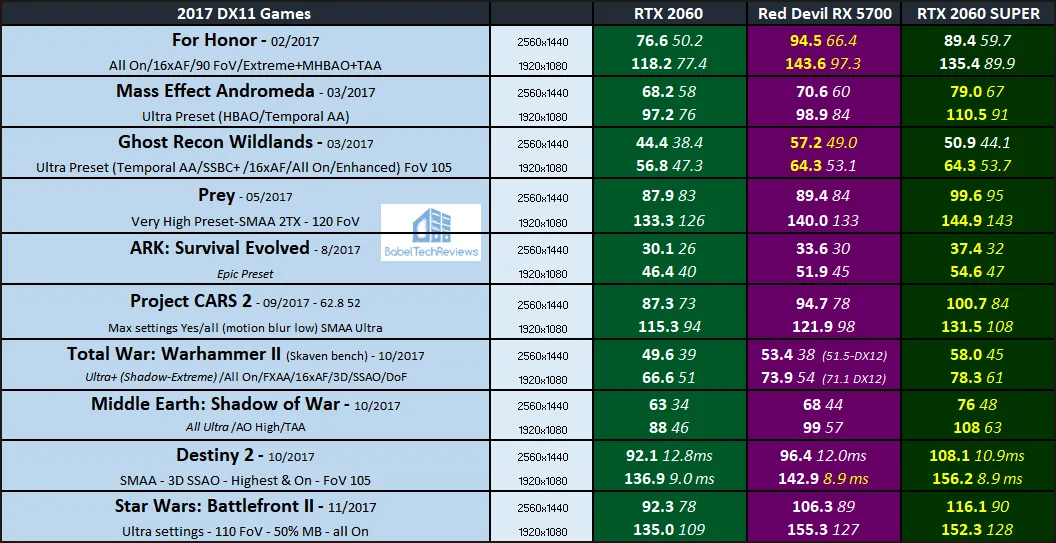
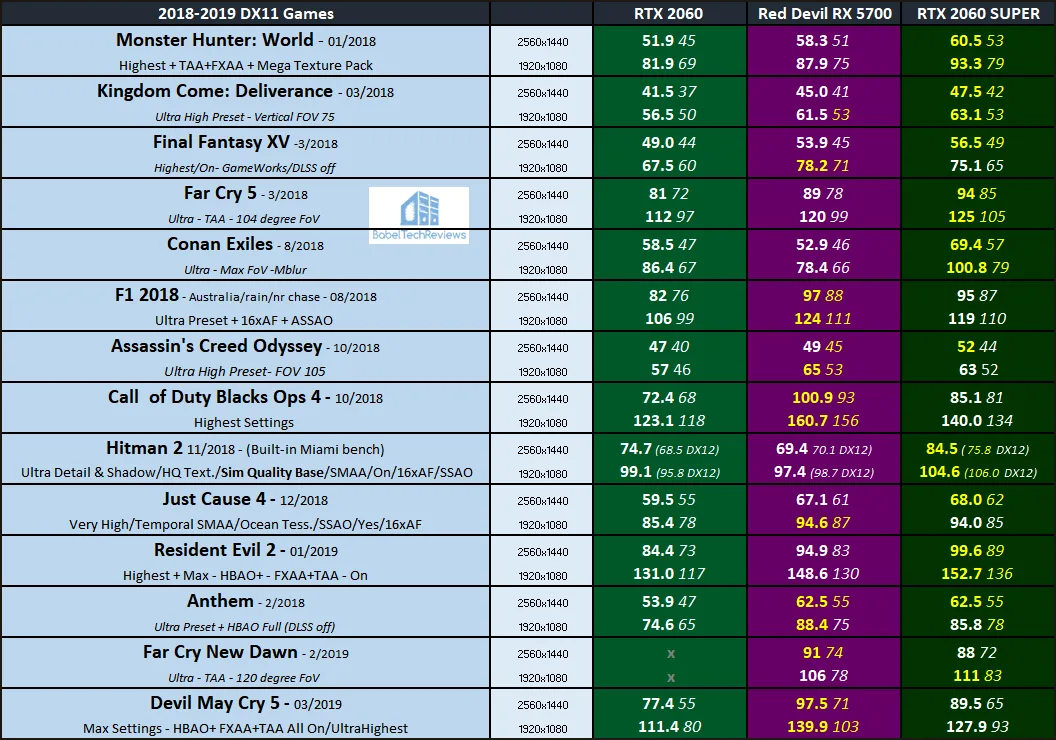
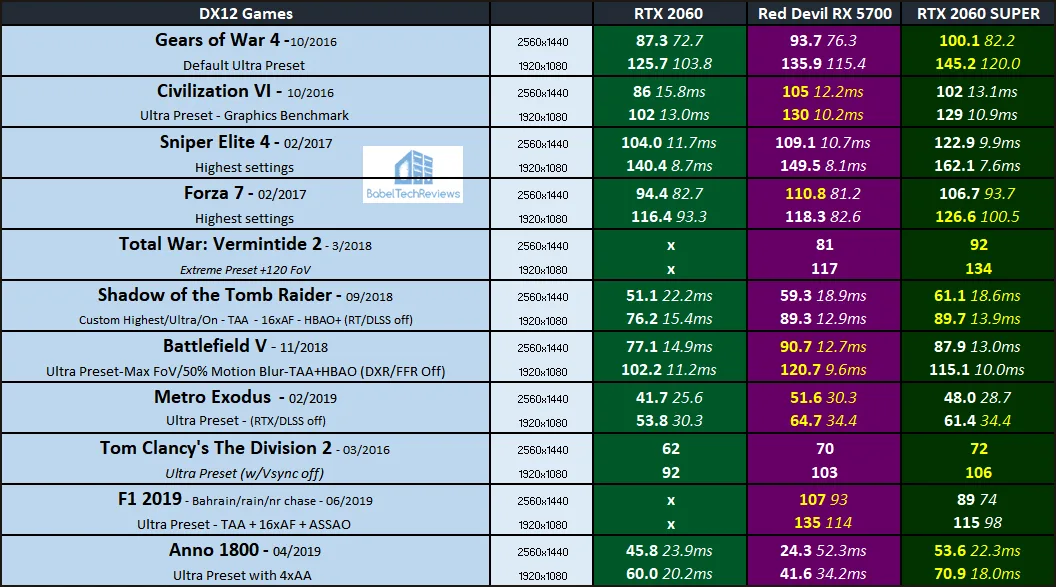

The Red Devil RX 5700 beats up on the RTX 2060 Founders Edition, but it only trades blows with the RTX 2060 SUPER Founders Edition, losing more games than it wins. There is no doubt that immature drivers are still holding back the RX 5700. Let’s see how the Red Devil RX 5700 fits in with our expanded main summary chart with a total of seven cards being compared.
The Main Summary Chart
This time the Red Devil RX 5700 sits in the middle of the pack with all of its performance results in yellow text so it stands out.
We see that the Red Devil RX 5700 destroys the RX Vega 56 and trades blows with the liquid-cooled RX Vega 64. The Red Devil RX 5700, however, will probably not be able to catch an RX 5700 XT even with a high overclock.
Although AMD’s Adrenalin drivers still have issues, they are much improved for the RX 5700 series compared with what launched a month ago. Assassin’s Creed Odyssey and some other games will still crash to desktop during the benchmark runs, and Anno 1800 exhibits poor performance even compared with the RX Vegas. This is not PowerColor’s fault, and we expect that AMD will continue to work on stability and increased performance for the RX 5700 cards.
It will be interesting to see if anything changes when we manually overclock our Red Devil RX 5700 to its maximum and pit it against the manually overclocked RTX 2060 in an overclocking showdown due at the weekend.
The Big Picture
Here we see the Red Devil RX 5700 performance compared with 15 other cards on recent drivers.
 Let’s head for our conclusion.
Let’s head for our conclusion.
The Conclusion
The Red Devil RX 5700 improves significantly over the RX Vega 56 and even trades blows against the former RX Vega 64 flagship, the overclocked liquid-cooled edition. The Red Devil RX 5700 beats the RTX 2060 FE soundly, and it also challenges the more expensive RTX 2060 SUPER FE although it loses more games than it wins.
The Red Devil RX 5700 is very good deal at $389.00 and it also includes an Xbox Game Pass for 3 months. We cannot recommend the reference blower RX 5700 at $350 unless you are prepared to put up with loud, hot, and with more limited overclocking chances.
Compared with the $389 Red Devil RX 5700, the RTX 2060 SUPER FE sells for $399 and the RTX 2060 sells for $349. Considering that the Red Devil RX 5700 XT is priced at $439, the RX 5700 non-XT Red Devil is priced pretty well. However, the PowerColor Red Dragon RX 5700 XT will be priced at $409 which is only twenty dollars more than the Red Devil RX 5700, and it will release next week with a lesser cooler and with no RGB lighting.
We would recommend the Red Devil RX 5700 as a great choice out of several good choices, especially if you are looking for good looks with RGB, an exceptional cooler, great performance for 2560×1440, PowerColor’s excellent support, and overall good value.
Let’s sum it up:
The Red Devil RX 5700 Pros
- The PowerColor Red Devil RX 5700 is much faster than the last generation RX Vegas by virtue of new RDNA architecture and its being fabricated on the 7nm process. It beats the RTX 2060 FE as it trades blows with the more expensive RTX 2060 SUPER FE.
- At $389 the Red Devil RX 590 is in the same price range as most premium RX 5700s. In addition, it comes with an Xbox Game pass for 3 months
- The Red Devil RX 5700 has excellent cooling with far less noise than any reference blower version
- The Red Devil RX 5700 has a very good power delivery and 2-fan custom cooling design that is very quiet even on the OC mode.
- Dual-BIOS give the user a choice of quiet with less overclocking, or a bit louder with more power-unlimited and higher overclocks.
- FreeSync2 HDR eliminates tearing and stuttering and it is much less expensive than comparable GSYNC displays.
- Customizable RGB lighting and a neutral color allow the Red Devil to fit into any color scheme using the DevilZone software program.
PowerColor Red Devil RX 5700 Cons
- Although RX 5700 drivers are still somewhat problematic, AMD is moving to address their stability issues and there has been good progress so far.
We cannot comment on the Red Devil’s ultimate overclock until the upcoming showdown with the RTX 2060. The Red Devil RX 5700 is a very good deal for those who game at 1920×1080 or 2560×1440, and it is a good alternative to the RTX 2060 SUPER, especially for those who prefer AMD cards and FreeSync2 enabled displays which are less expensive than GSYNC displays.
The Verdict:
- PowerColor’s Red Devil RX 5700 is a solidly-built handsome card with higher clocks out of the box than the reference version. It beats the RTX 2060 and trades blows with the RTX 2060 SUPER. It represents a solid value at $389 with a bundled 3-month XBox Game Pass, and it deserves BTR’s Editor’s Choice Award.
If you are buying right now, the PowerColor Red Devil RX 5700 is a kick ass card. The Red Devil RX 5700 offers a good alternative to the RTX 2060 or the RTX 2060 SUPER, and it also beats the performance of the last generation RX Vegas.
Stay tuned, there is more coming from BTR. This weekend we will continue with our Red Devil RX 5700 series versus the RTX 2060 in an overclocking showdown. Immediately afterward, we will return to VR with a performance evaluation using the Vive Pro and Oculus Rift comparing the RX 5700 cards with the SUPER cards.
August 16,2019 OVERCLOCKING UPDATE, 8 PM PDT
We only had 24 hours with the Red Devil RX 5700 before we posted our review. After spending another day with it, we are enjoying it for high quality 3440×1440 gaming. We intended to follow up with a red Devil RX 5700 Overclocking Showdown versus the RTX 2060 but it appears that AMD has limited overclocking.
Although Afterburner’s latest beta will allow you to increase the core voltage, you can’t override AMD’s registry settings without using a mod which will disable some of the card’s protection. With Afterburner, the Red Devil RX 5700’s overclock tops out at 1850MHz core and 930MHz memory but the card does not boost much higher than its regular 1780MHz. Increasing the voltage too much will affect the card’s stability.
Perhaps AMD will increase the overclocking limits later, but one should not expect a large overclocking performance boost without using a mod. We may return to RX 5700 overclocking later, but in the meantime we are setting up the Vive Pro for a series of VR showdowns between Navi and Turing.
It you would like to comment, please use the section below.
Happy Gaming!
